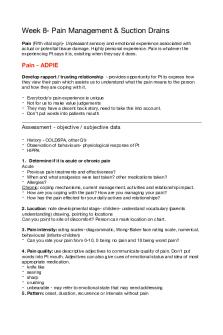Week 8 11.7.5-packet-tracer PDF

| Title | Week 8 11.7.5-packet-tracer |
|---|---|
| Author | Anonymous User |
| Course | Cisco I: Cisco Networking Basics |
| Institution | Monroe College |
| Pages | 3 |
| File Size | 1022 KB |
| File Type | |
| Total Downloads | 19 |
| Total Views | 147 |
Summary
Download Week 8 11.7.5-packet-tracer PDF
Description
Packet Tracer - Subnetting Scenario Addressing Table Device R1
Interface G0/0
IP Address
192.168.100.1 Bl ank
R1
R1
R2
G0/1
192.168.100.33
S0/0/0
192.168.100.129
G0/0
192.168.100.65
Bl ank
Bl ank
Bl ank
R2
G0/1
192.168.100.97
S0/0/0
192.168.100.158
R2
Bl ank
Bl ank
S1
VLAN 1
192.168.100.2 Bl ank
S2
VLAN 1
192.168.100.34 Bl ank
S3
VLAN 1
192.168.100.66 Bl ank
S4
VLAN 1
192.168.100.98 Bl ank
PC1
NIC
PC2
NIC
192.168.100.30 Bl ank
192.168.100.62 Bl ank
PC3
NIC
192.168.100.94
PC4
NIC
192.168.100.126
Bl ank
Bl ank
Subnet Ma sk
Default Gatewa y
255.255.255.224 Bl ank
N/A Bl ank
255.255.255.224 Bl ank
Bl ank
N/A
255.255.255.224 Bl ank
N/A
Bl ank
255.255.255.224 Bl ank
N/A Bl ank
N/A
255.255.255.224 Bl ank
Bl ank
255.255.255.224 Bl ank
N/A Bl ank
255.255.255.224 Bl ank
192.168.100.1 Bl ank
255.255.255.224 Bl ank
192.168.100.33 Bl ank
255.255.255.224 Bl ank
192.168.100.65 Bl ank
255.255.255.224 Bl ank
192.168.100.97 Bl ank
255.255.255.224 Bl ank
192.168.100.1 Bl ank
255.255.255.224 Bl ank
192.168.100.33 Bl ank
255.255.255.224 Bl ank
192.168.100.65 Bl ank
255.255.255.224 Bl ank
192.168.100.97 Bl ank
Objectives Pa rt 1: De sign an IP Addressing Scheme Pa rt 2: Assign IP Addresses to Network De vices and Verify Connectivity
Scenario In this activity, you are given the network address of 192.168.100.0/24 to subnet and provide the IP addressing for the Packet Tracer network. Each LAN in the network requires at least 25 addresses for end devices, the switch and the router. The connection between R1 to R2 will require an IP address for each end of the link.
Instructions Part 1: Design an IP Addressing Scheme Step 1: Subnet the 192.168.100.0/24 network into the appropriate number of subnets. Questions:
a.
Based on the topology, how many subnets are needed? 5 Type your answers here.
© 2014 - 2019 Cisco and/or its affiliates. All rights reserved. Cisco Public
Page 1 of 3
w w w.netacad.com
Pa cket Tracer - Subnetting Scenario
b.
How many bits must be borrowed to support the number of subnets in the topology table? Type your answers here. 3
c.
How many subnets does this create? 8
Type your answers here. d.
How many usable hosts does this create per subnet? 30
Type your answers here. Note: If your answer is less than the 25 hosts required, then you borrowed too many bits. e.
Calculate the binary value for the first five subnets. The first two subnets have been done for you. Network Address
Subnet
Bit 7
Bit 6
Bit 5
Bit 4
Bit 3
Bit 2
Bit 1
Bit 0
0
192.168.100.
0
0
0
0
0
0
0
0
1
192.168.100.
0
0
1
0
0
0
0
0
2
192.168.100.
0 Bl ank
3
Bl ank
4
192.168.100. Bl ank
f.
1
Bl ank
Bl ank
1
Bl ank
0
192.168.100.
1
0
Bl ank
0
1
Bl ank
Bl ank
Bl ank
0
0 blank
Bl ank
0
0 Bl ank
0 blank
0
Bl ank
Bl ank
0
blank
0 0
blank
0
Bl ank
0
Bl ank
0
0 0
blank
0
Bl ank
0
Bl ank
blank
Calculate the binary and decimal value of the new subnet mask. First Octet
Se cond Octet
Third Octet
11111111
11111111
11111111
First Decimal Octet
Se cond Decimal Octet
Third Decimal Octet
Mask Bit 7 Bl ank
1
Mask Bit 6 Bl ank
1
Mask Bit 5 Bl ank
1
Mask Bit 4
Mask Bit 3
0 blank
Mask Bit 2
0 Bl ank
Mask Bit 1
0 Bl ank
Mask Bit 0
0
0 Bl ank
blank
Fourth Decimal Octet blank
255. g.
255.
255.
224
Fill in the Subnet Table , listing the decimal value of all available subnets, the first and last usable host address, and the broadcast address . Repeat until all addresses are listed. Note: You may not need to use all rows.
Subnet Table Subnet Number 0
Subnet Address
192.168.100.0 Bl ank
1
192.168.100.32
2
192.168.100.64
3
192.168.100.96
Bl ank
Bl ank
Bl ank
4
192.168.100.128
5
192.168.100.160
Bl ank
Bl ank
First Usable Host Address
192.168.100.1 Bl ank
Last Usable Host Address
192.168.100.33
blank
192.168.100.62 Bl ank
192.168.100.65 Bl ank
192.168.100.94
192.168.100.129
Bl ank
© 2014 - 2019 Cisco and/or its af filiates. All rights reserved. Cisco Public
192.168.100.127 blank
192.168.100.159
192.168.100.158 Bl ank
192.168.100.161 Bl ank
192.168.100.95 blank
192.168.100.126
192.168.100.97 Bl ank
192.168.100.63 blank
Bl ank
Bl ank
192.168.100.31
192.168.100.30 Bl ank
Bl ank
Broadcast Address
blank
192.168.100.191
192.168.100.190 Bl ank
blank
Page 2 of 3
ww w.netacad.com
Pa cket Tracer - Subnetting Scenario
Subnet Number 6
Subnet Address
192.168.100.192 Bl ank
7
192.168.100.224
8
First Usable Host Address
192.168.100.193 Bl ank
192.168.100.225
Last Usable Host Address
192.168.100.222
Bl ank
192.168.100.254
Broadcast Address
192.168.100.223 blank
192.168.100.255
Bl ank
Bl ank
Bl ank
blank
Bl ank
Bl ank
blank
blank
blank
blank
blank
blank
blank
blank
blank
blank
9 10
Step 2: Assign the subnets to the network shown in the topology. a.
Assign Subnet 0 to the LAN connected to the GigabitEthernet 0/0 interface of R1:192.168.100.0 /27
b.
Assign Subnet 1 to the LAN connected to the GigabitEthernet 0/1 interface of R1: 192.168.100.32 /27
c.
Assign Subnet 2 to the LAN connected to the GigabitEthernet 0/0 interface of R2: 192.168.100.64 /27
d.
Assign Subnet 3 to the LAN connected to the GigabitEthernet 0/1 interface of R2: 192.168.100.96 /27
e.
Assign Subnet 4 to the WAN link between R1 to R2: 192.168.100.128 /27
Step 3: Document the addressing scheme. Fill in the Addressing Table using the following guidelines: a.
Assign the first usable IP addresses in each subnet to R1 for the two LAN links and the WAN link.
b.
Assign the first usable IP addresses in each subnet to R2 for the LAN links. Assign the last usable IP address for the WAN link.
c.
Assign the second usable IP address in the attached subnets to the switches.
d.
Assign the last usable IP addresses to the PCs in each subnet.
Part 2: Assign IP Addresses to Network Devices and Verify Connectivity Most of the IP addressing is already configured on this network. Implement the following steps to complete the addressing configuration. EIGRP dynamic routing is already configured between R1 and R2.
Step 1: Configure R1 LAN interfaces. a.
Configure both LAN interfaces with the addresses from the Addressing Table.
b.
Configure the interfaces so that the hosts on the LANs have connectivity to the default gateway.
Step 2: Configure IP addressing on S3. a.
Configure the switch VLAN1 interface with addressing.
b.
Configure the switch with the default gateway address.
Step 3: Configure PC4. Configure PC4 with host and default gateway addresses.
Step 4: Verify connectivity. You can only verify connectivity from R1, S3, and PC4. However, you should be able to ping every IP address listed in the Addressing Table . End of Document
© 2014 - 2019 Cisco and/or its af filiates. All rights reserved. Cisco Public
Page 3 of 3
ww w.netacad.com...
Similar Free PDFs

Week 8 quiz - Week 8
- 19 Pages

Week 8 questions - Week 8
- 4 Pages

FIN111 Week 8 - Week 8 tutorial
- 2 Pages

DQ1 week 8 - DQ1 week 8
- 1 Pages

KIT-Week 8 - KIT-Week 8
- 5 Pages

Week 8 - Lecture notes 8
- 6 Pages

Week 8 - Lecture notes 8
- 23 Pages

WEEK 8 - Lecture notes 8
- 10 Pages

Week 8 case study
- 6 Pages

Week 8 MAST-G
- 1 Pages

Qualtrics Discussion - Week 8
- 1 Pages

Week 8 Tut Answers.
- 3 Pages

Teori Akuntansi WEEK 8
- 7 Pages
Popular Institutions
- Tinajero National High School - Annex
- Politeknik Caltex Riau
- Yokohama City University
- SGT University
- University of Al-Qadisiyah
- Divine Word College of Vigan
- Techniek College Rotterdam
- Universidade de Santiago
- Universiti Teknologi MARA Cawangan Johor Kampus Pasir Gudang
- Poltekkes Kemenkes Yogyakarta
- Baguio City National High School
- Colegio san marcos
- preparatoria uno
- Centro de Bachillerato Tecnológico Industrial y de Servicios No. 107
- Dalian Maritime University
- Quang Trung Secondary School
- Colegio Tecnológico en Informática
- Corporación Regional de Educación Superior
- Grupo CEDVA
- Dar Al Uloom University
- Centro de Estudios Preuniversitarios de la Universidad Nacional de Ingeniería
- 上智大学
- Aakash International School, Nuna Majara
- San Felipe Neri Catholic School
- Kang Chiao International School - New Taipei City
- Misamis Occidental National High School
- Institución Educativa Escuela Normal Juan Ladrilleros
- Kolehiyo ng Pantukan
- Batanes State College
- Instituto Continental
- Sekolah Menengah Kejuruan Kesehatan Kaltara (Tarakan)
- Colegio de La Inmaculada Concepcion - Cebu


